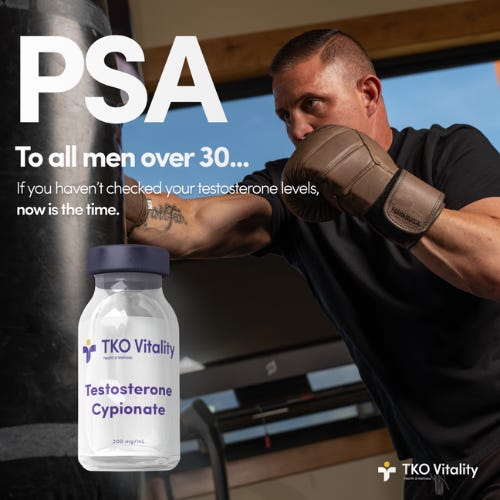Testosterone Replacement Therapy (TRT) offers transformative benefits for men with low testosterone, enhancing energy, strength, and overall well-being. However, it can also increase red blood cell production, leading to a condition called polycythemia, which requires careful monitoring to ensure safety. At TKO Vitality, we emphasize regular blood work and tailored strategies to manage polycythemia, making TRT both effective and safe for long-term health.
Start your TRT journey with expert oversight to optimize your health safely. Book your consultation today at TKOVitality.co/schedule.
Why Blood Work Is Non-Negotiable on TRT
TRT stimulates red blood cell production, which can improve oxygen delivery but may thicken your blood if levels become excessive, a condition known as polycythemia. Studies show that 10–20% of men on TRT develop polycythemia, potentially increasing cardiovascular risks if unaddressed (Ohlander et al., 2018). At TKO Vitality, we prioritize comprehensive lab monitoring to manage this side effect, ensuring you can safely enjoy the benefits of testosterone optimization.
What Are the Key Blood Markers?
Understanding Polycythemia and Its Management
- Hematocrit: The percentage of blood composed of red blood cells; levels above 52–54% signal polycythemia (Bhasin et al., 2018).
- Hemoglobin: The oxygen-carrying protein in red blood cells; elevated levels indicate increased blood viscosity (Cunningham et al., 2016).
- RBC Count: The total number of red blood cells; excessive counts contribute to thickened blood (Ohlander et al., 2018).
- A 2016 study in The New England Journal of Medicine found that 10–20% of TRT users experience elevated hematocrit, particularly with higher doses (Cunningham et al., 2016).
- TKO Vitality’s regular lab testing catches these changes early for timely intervention.
Why Does Polycythemia Matter?
- Thickened blood reduces flow, potentially causing high blood pressure, headaches, dizziness, fatigue, chest pain, shortness of breath, or increased risk of clots, stroke, or heart attack (Kovac et al., 2020).
- A 2019 review in The Journal of Clinical Endocrinology & Metabolism noted that unmonitored polycythemia can elevate cardiovascular risks, but proper management eliminates this concern (Ramasamy et al., 2019).
- Our providers monitor for symptoms and lab changes to keep you safe.
Management Through Blood Donation:
- Therapeutic phlebotomy (donating blood) lowers red blood cell volume, reducing hematocrit and improving circulation (Bhasin et al., 2018).
- A 2020 study in Urology reported that blood donation normalized hematocrit in 85% of TRT patients with polycythemia (Kovac et al., 2020).
- TKO Vitality encourages blood donation 2–3 times per year as a simple, beneficial solution.
Additional Management Strategies:
- Adjusting TRT dosage or switching to lower-dose TET (e.g., oral nutraceuticals) can reduce red blood cell production while maintaining benefits (Snyder et al., 2017).
- Staying hydrated and avoiding smoking further lowers viscosity risks (Ohlander et al., 2018).
- Our specialists personalize protocols to manage polycythemia effectively.
How Often Should You Test?
- Labs every 3–6 months are critical on TRT, monitoring hematocrit, hemoglobin, RBC, and iron/ferritin levels (Ramasamy et al., 2019).
- Hematocrit above 52% requires evaluation to maintain a safe range and protect long-term health (Cunningham et al., 2016).
- TKO Vitality’s $86/week plan includes at-home or local lab testing for precise monitoring.
What to Know Before Starting TRT
Lifestyle Integration:
- Stay hydrated, eat a balanced diet, and exercise 150 minutes/week to support blood health and TRT efficacy (Ohlander et al., 2018).
- Avoid smoking and excessive alcohol, which can worsen blood viscosity.
- Regular blood donation can proactively manage red blood cell levels.
Risks and Considerations:
- Polycythemia is common (10–20% of TRT users) but manageable with phlebotomy or dose adjustments (Cunningham et al., 2016).
- Untreated polycythemia may increase cardiovascular risks, but proactive monitoring eliminates this concern (Ramasamy et al., 2019).
- Other TRT side effects, like mild acne, are also manageable with proper care.
Medical Supervision:
- Comprehensive labs (hematocrit, hemoglobin, hormone panel, iron levels) are essential before and during TRT.
- TKO Vitality’s $86/week plan includes lab testing, coaching, and tailored protocols.
- Use FDA-approved medications for safe, effective therapy.
How TKO Vitality Supports Your TRT Journey
Get started with TKO Vitality:
- At-home or local lab testing to monitor hematocrit, hemoglobin, and overall health.
- Video consultations with specialists to customize TRT dosing and polycythemia management.
- Personalized protocols: phlebotomy guidance, nutrition, exercise, and coaching for 90% satisfaction rates within 12 weeks (clinic data).
- Ongoing support to optimize testosterone safely and sustain vitality.
Ready to Optimize TRT Safely?
- Fatigue, low libido, or muscle loss due to low testosterone.
- Concerns about TRT side effects like polycythemia.
- Desire for a safe, monitored path to vitality.
If you’re experiencing:
Book a consultation at TKOVitality.co/schedule. Our evidence-based approach ensures safe, effective TRT with expert blood monitoring.
Ready to Reclaim Your Vitality?
Wellness is achievable; TKO Vitality provides the roadmap.
Does this sound like you?
- Struggling with Symptoms: Fatigue, low libido, or low energy holding you back.
- Worried About Risks: Concerned about TRT’s impact on blood health.
- Health Goals: Seeking strength, confidence, and vitality.
Book a free 15-minute consult today at TKOVitality.co/schedule and discover how TKO Vitality can transform your health safely.

Don’t wait—low testosterone affects millions, and polycythemia is manageable with proper care. Join thousands transforming their lives with TKO Vitality.
References:
- Bhasin, S., et al. (2018). Testosterone therapy in men with hypogonadism: An Endocrine Society clinical practice guideline. The Journal of Clinical Endocrinology & Metabolism, 103(5), 1715–1744.
- Cunningham, G. R., et al. (2016). Testosterone treatment and sexual function in older men with low testosterone levels. The New England Journal of Medicine, 374(7), 611–624.
- Kovac, J. R., et al. (2020). Management of erythrocytosis in men on testosterone replacement therapy: A retrospective analysis. Urology, 140, 101–106.
- Ohlander, S. J., et al. (2018). Erythrocytosis following testosterone therapy. Sexual Medicine Reviews, 6(1), 77–85.
- Ramasamy, R., et al. (2019). Risks and benefits of testosterone therapy: A review. The Journal of Clinical Endocrinology & Metabolism, 104(6), 2161–2172.
- Snyder, P. J., et al. (2017). Effects of testosterone treatment in older men. The Lancet, 389(10069), 1639–1648.